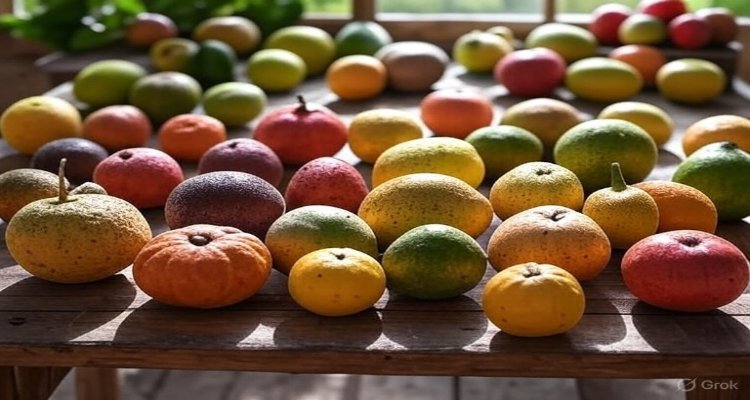The Forgotten Fruits No One Alive Has Tasted
Discover the story of long-lost and extinct fruits that vanished before modern society could enjoy them, and what scientists are doing to bring their flavors back.
Introduction: The Fruits Beyond Memory
Imagine a fruit so unique in taste and fragrance that it once defined a community’s cuisine, yet no one alive today has ever tasted it. These are not mythical creations or distant legends, but real fruits that disappeared through centuries of climate change, colonial expansion, and monoculture farming. Known in archives and botanical records but absent from human memory, these “forgotten fruits” offer a bittersweet glimpse into humanity’s lost relationship with biodiversity.
Context & Background: A History of Vanishing Flavors
Throughout history, fruits have been central to culture, trade, and survival. Bananas, mangoes, apples, and grapes dominate today’s markets, but thousands of lesser-known fruits once flourished across regions. Many vanished due to:
-
Deforestation: Expanding cities and agriculture destroyed ecosystems where rare fruits grew.
-
Colonization & Trade Priorities: Crops like sugarcane, coffee, and cotton replaced local varieties, pushing obscure fruits into extinction.
-
Disease & Genetic Narrowing: Monoculture farming prioritized yield over diversity, making rare fruits more vulnerable to blights.
Historical records still describe some of these fruits in detail—Arabic travelers wrote of golden-hued pears from Persia, European explorers noted tart, wild melons in Africa, and ancient Ayurvedic texts in India reference fruits no modern botanist has identified.
Main Developments: Tracking the Lost Fruits
In recent decades, scientists and ethnobotanists have been working to rediscover or at least document these missing fruits. Some examples include:
-
The Judean Date Palm: Once a thriving fruit of the Middle East, extinct for centuries until ancient seeds were found in an archaeological site and grown successfully in Israel.
-
Silphium: A plant-like fruit prized in ancient Rome for flavor and medicine, described as “worth its weight in silver.” It disappeared entirely, possibly due to overharvesting.
-
The Madagascan Obscure Melons: Mentioned in 17th-century French records, these melon-like fruits are believed to have been wiped out during deforestation.
-
Indian Wild Custard Fruits: Documented in old Sanskrit texts, these fruits seem related to today’s custard apple but with distinct taste profiles, now lost to extinction.
Genetic banks and agricultural institutes are racing to preserve rare seeds to avoid repeating the same mistake with fruits currently endangered, such as wild varieties of apricot and papaya.
Expert Insight & Public Reaction
“Every extinct fruit represents a lost flavor, a lost culture, and a lost genetic strategy of survival,” explains Dr. Helena Rodríguez, a conservation biologist focused on forgotten crops. “Modern diets are dominated by fewer than 20 plant species, yet historically humans consumed thousands. The disappearance of fruits narrows both our palate and our biodiversity resilience.”
Among the public, the idea of lost tastes fascinates and saddens. Social media discussions under hashtags like **#Lostavors and **#Forgottenuits often reflect a mix of nostalgia for something never tasted and hope that science may revive them.
Impact & Implications: Can They Return?
The question now is not only whether these fruits can be brought back, but whether we should. Seed preservation programs, genetic reconstruction, and intercropping with surviving relatives may reintroduce some forgotten species. However, ecological rebalancing is complex. Reviving extinct fruits raises challenges:
-
Environmental Constraints: Original habitats may no longer exist.
-
Economic Incentives: Farmers may resist cultivating low-yield, unfamiliar fruits.
-
Ethical Questions: Should scarce research funding go into resurrecting ancient flavors instead of saving endangered present-day crops?
At the same time, culinary innovation drives interest. High-end chefs and food historians advocate for rediscovering rare fruits to diversify diets, combat climate risks, and reclaim cultural heritage.
Conclusion: Remembering What We’ve Forgotten
The story of forgotten fruits is about more than vanished flavors. It reflects humanity’s fragile connection to nature and the choices that led us to favor uniformity over diversity. As seed banks store the last whispers of ancient harvests, one thing is clear: in forgetting these fruits, we’ve lost pieces of history, culture, and resilience. Whether through science or storytelling, remembering them is the first step toward ensuring the next generation does not inherit a blander, narrower future.
Disclaimer : This article is for informational purposes only. The content is based on historical research, expert commentary, and conservation studies. It should not be taken as dietary or scientific advice without consulting verified sources.











